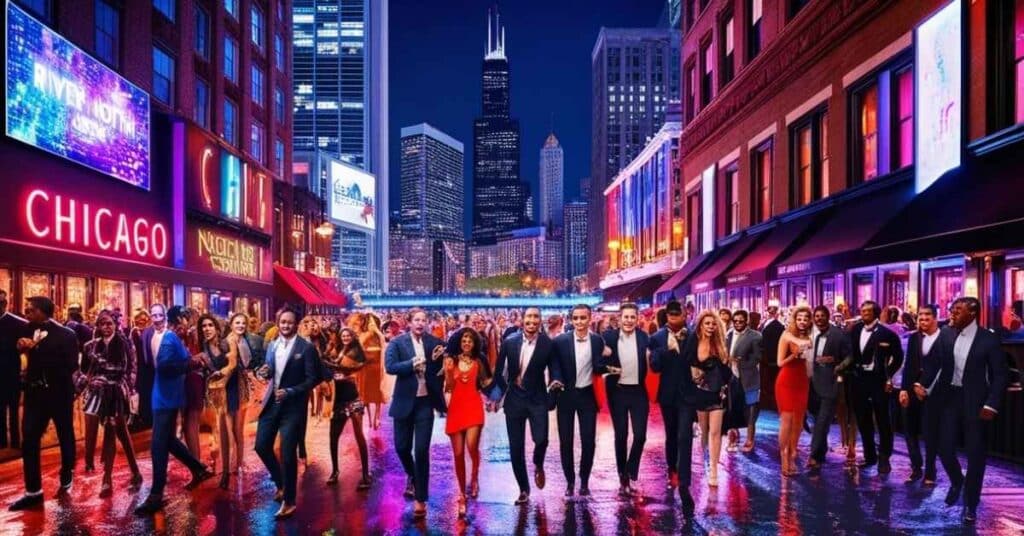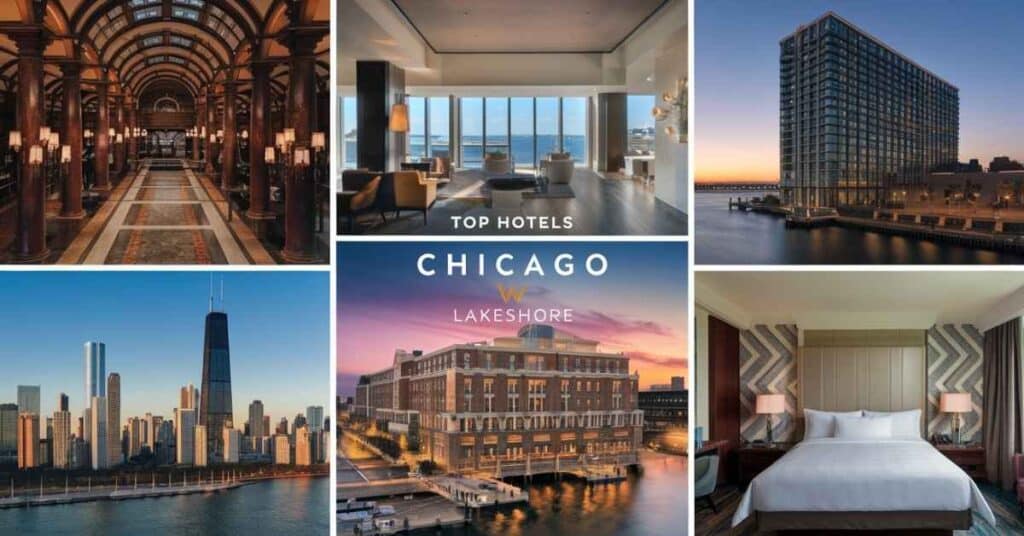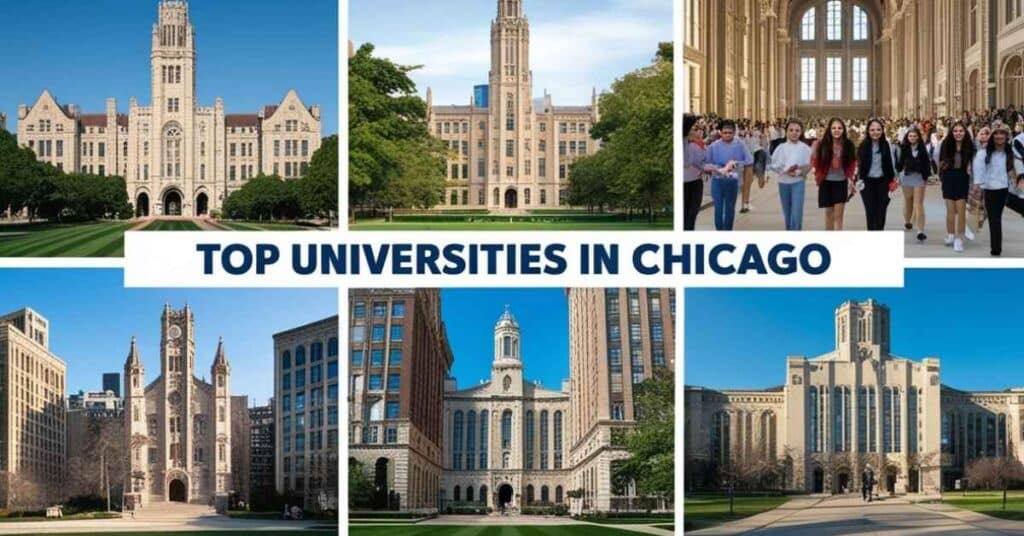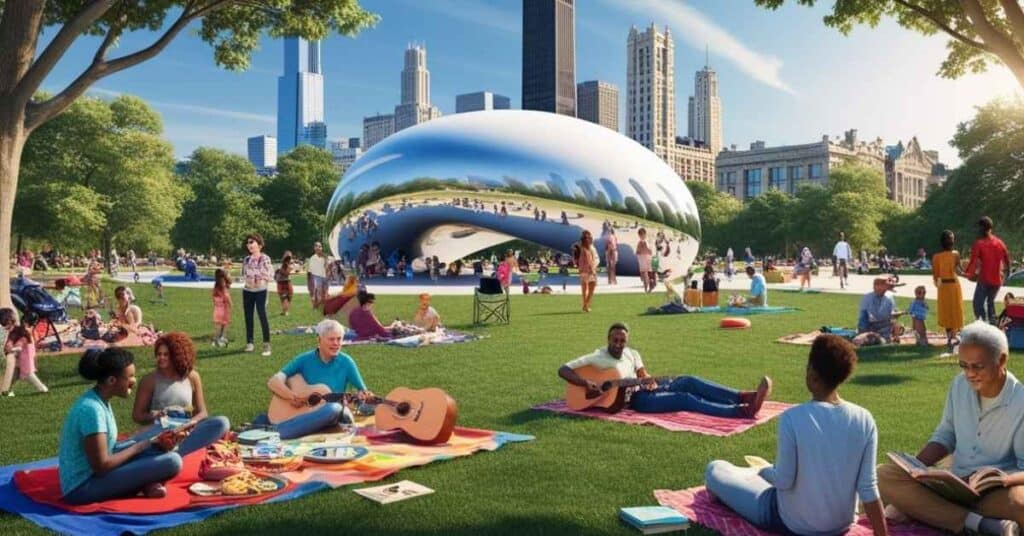Did you know that Chicago is home to the world’s first skyscraper? The Home Insurance Building, completed in 1885, was a marvel of engineering that changed the skyline forever. As you stroll through the Windy City, every corner reveals stories of innovation and culture, waiting to be discovered.
So why wait? Plan your trip to Chicago today, Whether you are wandering through the artsy streets of Wicker Park or enjoying a deep dish pizza in Lincoln Park, this city promises unforgettable experiences. Explore its unique neighborhoods and immerse yourself in the local culture.
Geographic Overview of chicago
Chicago’s distinct geography, nestled along Lake Michigan, shapes its climate, scenery, and urban layout
City Limits and Area
Chicago covers an area of approximately 234 square miles. This vast urban stretch includes bustling commercial centers, densely populated residential areas, and vast stretches of green spaces that line Lake Michigan.
This large footprint makes Chicago the third largest city by population and one of the largest by area in the United States. Here is a quick look at its geographic characteristics:
| Characteristic | Detail |
| Total Area | 234 square miles |
| Water Area | 27 square miles (Lake Michigan) |
| Elevation | 594 feet above sea level |
| City Length | Approximately 26 miles north south |
| City Width | Approximately 15 miles east west |
Lake Michigan and Natural Geography

Located on the southwestern shore of Lake Michigan, one of the largest freshwater lakes in the world, Chicago has a unique climate influenced by the lake. Summers bring cool lake breezes, while winters often feel harsher with winds sweeping off the lake.
Lake Michigan is central to Chicago’s character; it serves as a natural boundary, an economic driver, and a scenic waterfront.
77 Community Areas in Chicago
Chicago comprises 77 unique community areas that highlight the city’s diversity. Each neighborhood tells its own story, reflecting the culture of its residents, from Pilsen’s artistic flair to Hyde Park’s historic grandeur. These areas foster a sense of belonging and play a crucial role in local governance and urban development.
Influence of Natural Borders
In addition to Lake Michigan, Chicago’s borders are marked by the Chicago River and Calumet River, which wind through the city and divide neighborhoods. These rivers have historically served as industrial channels but are now being revitalized to enhance public accessibility and recreation.
Here’s a fresh, engaging take with catchy H2 and H3 headings that emphasize the distinctiveness of Chicago’s size and how it compares to other major cities.
Chicago vs. the World’s Largest Cities

Now we explore how Chicago compares to the world’s largest cities in terms of land area and population.
| City | Area (234 square miles) | Population Density Insight |
| Chicago | 234 | High population, spread over large area |
| Milwaukee | 97 | Small city size, feels suburban next to Chicago |
| New York City | 469 | Very high density, multiple large boroughs |
| Boston | 89 | Compact and dense, almost half water area |
| Los Angeles | 503 | Sprawling but low density, car dependent |
| San Francisco | 232 | Compact land area, dense and urbanized |
| London | 671 | Large area, vast population in metro region |
| Paris | 40 | Small but extremely dense, high cultural influence |
| Beijing | 6336 | Expansive area with dense urban and rural mix |
Milwaukee: A Glimpse of the Windy City
Chicago dwarfs its neighbor to the north, with Milwaukee covering only 97 square miles, making it look like a suburb in comparison. Despite being the largest city in Wisconsin, Milwaukee’s footprint barely nudges Chicago’s borders.
New York City: A Giant in Every Measure
At 469 square miles, New York is not only bigger but also denser, especially in boroughs like Brooklyn, where the population rivals all of Chicago. Despite Chicago’s impressive sprawl, NYC’s size and density are a class apart.
Boston: Small in Size, Big in Spirit
Boston covers a compact 89 square miles and consists of nearly 50% water. Its land area is just a fraction of Chicago’s, showing that sometimes, it’s not the size but the impact that counts.
Los Angeles: Wide Open Spaces, Less Density
With 503 square miles of land, Los Angeles is more than twice Chicago’s size in area. Yet with a far lower population density, LA’s layout sprawls, relying heavily on car travel rather than a dense public transit system.
San Francisco: Size Matters with the Bay
When you include the bay, San Francisco covers 232 square miles, close to Chicago’s footprint. However, in land area alone, SF spans just 46.8 square miles—a compact space for such a renowned city.
London: An Empire Sized Metropolis
London’s 671 square miles dwarf Chicago’s, spanning more than twice its area and housing nearly 10 million residents. With an extensive metropolitan spread, London’s scale makes even Chicago feel cozy.
Paris: The City of Lights
Paris covers only 40 square miles of land, yet is home to over 2.2 million people. It’s a reminder that a city’s charm isn’t always tied to size, but to its density, history, and culture.
Beijing: A City on a Different Scale
Explore Chicago’s diverse population and demographic trends that shape the city’s vibrant identity.
Beijing’s 6,336 square miles make it one of the largest cities in the world, making Chicago’s 234 square miles footprint seem minuscule. With dozens of Chinese cities that surpass Chicago’s population, it’s easy to see how urban scale can redefine expectations.
Read Further About “What Are the Typical Dimensions of a Flower Bouquet?”
Travel Times Around Chicago City
Navigating Chicago offers a unique experience with its extensive transportation options. This overview highlights average travel times for different modes of transportation, including trains, cars, bicycles, and walking, enabling you to plan your journey across this vibrant city effectively.
| Mode of Transportation | Average Speed | Distance (Approx.) | Estimated Travel Time |
| Train | 30 mph | 75 miles | 2.5 hours |
| Car | 35 mph | 75 miles | ~2.14 hours (~2 hours 8 minutes) |
| Air (small aircraft) | 150 mph | 75 miles | 0.5 hours (30 minutes) |
| Bicycle | 12 mph | 75 miles | ~6.25 hours (~6 hours 15 minutes) |
| On foot | 3 mph | 75 miles | 25 hours |
Top Hotels in Chicago

Discover the finest accommodations that Chicago has to offer, blending luxury with unique experiences.
Palmer House Hilton
When visiting Chicago, the Palmer House Hilton is a historic landmark that blends modern luxury with rich history, featuring elegant rooms and a stunning lobby.
Thompson Chicago
For a more contemporary experience, the Thompson Chicago offers sleek accommodations and stunning views of Lake Michigan, making it a perfect choice for travelers seeking sophistication.
W Chicago Lakeshore
The W Chicago Lakeshore combines a vibrant atmosphere with convenient access to the waterfront, providing guests with both relaxation and excitement.
Ritz Carlton Chicago
Lastly, the Ritz Carlton Chicago provides an unparalleled level of service, with lavish rooms and fine dining options that make for a memorable stay.
Top Universities in Chicago

Explore prestigious educational institutions that shape the minds of future leaders.
University of Chicago
Chicago is home to prestigious universities that attract students from around the world. The University of Chicago, renowned for its rigorous academics and distinguished faculty, is consistently ranked among the top universities globally.
Northwestern University
This offers a comprehensive range of programs and a vibrant campus life, fostering an engaging educational environment.
Loyola University Chicago
This is known for its strong commitment to social justice and community service, providing a well-rounded educational experience.
DePaul University
With its diverse student body and flexible programs, offers excellent opportunities for students pursuing various fields of study.
University of Michigan
While not located in Chicago, the University of Michigan is a prestigious institution in nearby Ann Arbor. It is recognized for its research programs and vibrant campus, attracting students from across the globe.
Read Further “How Big is New York City? Dimensions and Population Over Time”
Top Health Systems in Chicago
The health system in Chicago is robust, featuring several renowned hospitals and healthcare facilities.
Northwestern Memorial Hospital
Northwestern Memorial Hospital is consistently ranked among the best hospitals in the nation, providing comprehensive medical services and cutting-edge research.
University of Chicago Medical Center
That is known for its advanced treatments and innovative research programs, making it a leader in healthcare.
Rush University Medical Center
Additionally, Rush University Medical Center offers exceptional care with a strong emphasis on patient-centered services. These health systems ensure that residents and visitors have access to top-quality medical care, reinforcing Chicago’s reputation as a leading urban center.
Chicago’s History: Growth and Expansion

Explore how Chicago transformed from a modest settlement to a bustling metropolis, shaping its unique character and vibrant culture
Early Settlement and Incorporation
Chicago’s story began with Native American settlements who benefited from the rivers and lake access long before Europeans arrived. By the early 1800s, French explorers and traders had established a presence, taking advantage of the natural water routes.
Chicago was officially incorporated in 1837 and rapidly grew due to its strategic position as a transportation and trade hub between the eastern U.S. and the expanding west.
Great Chicago Fire and Urban Rebuilding
The Great Chicago Fire of 1871 remains one of the most pivotal moments in Chicago’s history. Though it destroyed much of the city, it also prompted a period of rapid rebuilding and urban planning that established Chicago as a leader in urban development.
In the years following the fire, prominent architects like Louis Sullivan helped reshape the city with innovative designs, setting the stage for Chicago’s famed skyline.
20th Century Growth and Development
By the 20th century, Chicago emerged as a national economic powerhouse, fueled by booming industries and transportation innovations. Today, the city evolves with urban renewal projects like the Riverwalk and the redevelopment of neighborhoods such as the West Loop and Fulton Market District.
Check it Out Our Article “How Big is 2 Inches? 15 Everyday Items for Comparison”
Population and Demographics: Who Lives in Chicago?
Discover the rich tapestry of Chicago’s residents and the demographic dynamics that define this vibrant city.
Population Overview and Density
Recent estimates show Chicago has about 2.7 million residents, making it the third most populous city in the U.S., with a density of approximately 11,800 people per square mile. This density varies significantly by neighborhood, with the Loop being particularly crowded due to its apartments, offices, and amenities
Cultural Diversity in Chicago
Chicago boasts a vibrant cultural diversity, with notable African American, Hispanic, Asian, and Polish communities. Neighborhoods like Chinatown, Little Italy, and Ukrainian Village showcase the rich traditions, cuisines, and languages that define the city’s identity.
Socioeconomic Profile
The city’s economic landscape is as varied as its cultural one. While Chicago has affluent areas like the Gold Coast, it also has neighborhoods that experience economic challenges. This socioeconomic diversity shapes the city’s policies and impacts everything from its education system to public services.
Chicago’s Economy
Explore the diverse industries and employment trends that drive Chicago’s economy and contribute to its status as a major economic hub.
Key Economic Sectors
Chicago’s economy is highly diversified, driven by industries such as finance, technology, healthcare, education, and manufacturing. Home to major corporations like Boeing, McDonald’s, and United Airlines, Chicago plays a crucial role in the national economy. Here’s a look at the city’s top economic sectors:
- Finance and Insurance: Anchored by the Chicago Board of Trade and CME Group.
- Healthcare: A rapidly growing sector, with facilities like Northwestern Memorial Hospital and Rush University Medical Center.
- Technology: Chicago’s Silicon Prairie is attracting tech startups and entrepreneurs.
Employment Statistics
The city’s workforce is a blend of skilled professionals, industrial laborers, and service workers, with an unemployment rate around the national average. Chicago’s economic landscape continues to grow, attracting new businesses and retaining a strong manufacturing base.
Read More About “How Long is 999 Seconds? Practical Insights and Fun Facts”
Transportation and Accessibility in Chicago
Experience how Chicago’s vast transportation system and accessibility link residents and visitors to the city’s dynamic neighborhoods and attractions.
Public Transit Systems
Chicago’s public transportation system is one of the most extensive in the nation, with the Chicago Transit Authority (CTA) operating buses and the L train network, which includes eight distinct train lines. Here’s a quick look at some essential transit facts:
| Mode | Coverage |
| CTA L Trains | 145 stations, 224 miles |
| CTA Buses | 129 routes |
| Metra Trains | 11 lines to suburbs |
Bike and Pedestrian Friendly Features

Chicago’s commitment to green commuting is visible in its extensive network of bike lanes, the Divvy bike sharing program, and pedestrian friendly streets. The Chicago Riverwalk is another popular destination, offering walkable paths and riverside cafes that promote urban exploration.
Airports and Highways
Chicago is served by O’Hare International Airport and Midway Airport, making it a vital transportation hub. Additionally, major highways like Interstate 90 connect Chicago to other major Midwest cities.
Neighborhood Highlights in Chicago
Chicago’s neighborhoods are diverse and dynamic. Some highlights include:
- Lincoln Park: Known for its affluent homes, the zoo, and DePaul University.
- Wicker Park: A trendy area with vibrant nightlife, restaurants, and shopping.
- Pilsen: A historically Mexican American community celebrated for its street art and food.
Each neighborhood contributes to Chicago’s cultural diversity and provides a sense of identity for residents.
Chicago’s Arts Scene and Cultural Events
Chicago has a rich arts scene with world renowned institutions such as the Art Institute of Chicago and the Museum of Contemporary Art. The city hosts events like the Chicago Jazz Festival and Lollapalooza, drawing visitors worldwide to experience its musical and artistic heritage.
For further informatiot “12 Things and Animals That Are 10 Feet Long”
Tourism and Attractions in Chicago

Some of Chicago’s most famous landmarks include:
- Millennium Park: Home to Cloud Gate, also known as “The Bean.”
- Navy Pier: A 3,300 foot long pier offering shops, rides, and a Ferris wheel.
- Willis Tower: Formerly the Sears Tower, known for its Skydeck with views across the city.
Shopping and Entertainment
The Magnificent Mile is a shopping haven, while River North boasts art galleries and chic restaurants. These destinations make Chicago a major tourism magnet, contributing significantly to its economy.
Chicago’s Famous Foods and Dining Spots

Chicago’s culinary landscape boasts iconic dishes and vibrant dining spots that reflect the city’s rich cultural heritage.
- Deep Dish Pizza: A thick, cheesy pizza created by Pizzeria Uno.
- Chicago Style Hot Dog: Topped with mustard, onions, relish, and more.
- Italian Beef: A sandwich with seasoned beef, usually topped with giardiniera.
The West Loop neighborhood has become a foodie’s paradise, with a variety of award winning restaurants.
Continue Reading “What Are The Dimensions of a Pringles Can?”
FAQs
1. What is Chicago famous for?
Chicago is known for its architecture, including the first skyscraper, deep-dish pizza, jazz music, and vibrant neighborhoods.
2. Why is Chicago called the “Windy City”?
The term “Windy City” is believed to refer to both Chicago’s breezy weather and its history of boastful politicians.
3. What are popular attractions in Chicago?
Top attractions include Millennium Park, Navy Pier, the Art Institute of Chicago, and the Willis Tower.
Conclusion: What Makes Chicago Unique?
With its unique geography, rich history, diverse population, and impressive urban development, Chicago remains an essential American city. From its influential role in architecture to its culinary delights and vibrant cultural scene, the Windy City is a city of both tradition and innovation.
Read Further “10 Everyday Items That Are 10 Centimeters Long”

My name is Linda, and I am an experienced blogger with a passion for precision and craftsmanship. With years of expertise, I contribute to Accura Matrics, bringing a wealth of knowledge and a keen eye for detail. My insightful articles and expert tips are designed to help readers achieve excellence in their measurements and dimensions projects, offering valuable guidance in the pursuit of accurate and thoughtful design.

